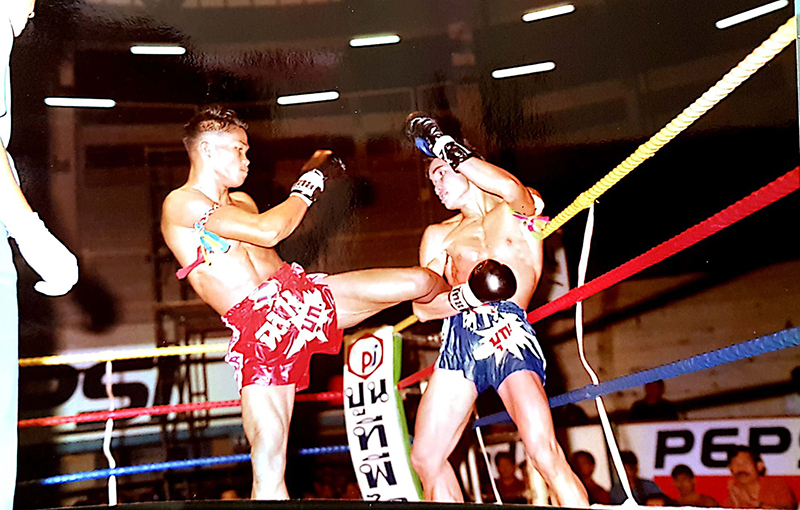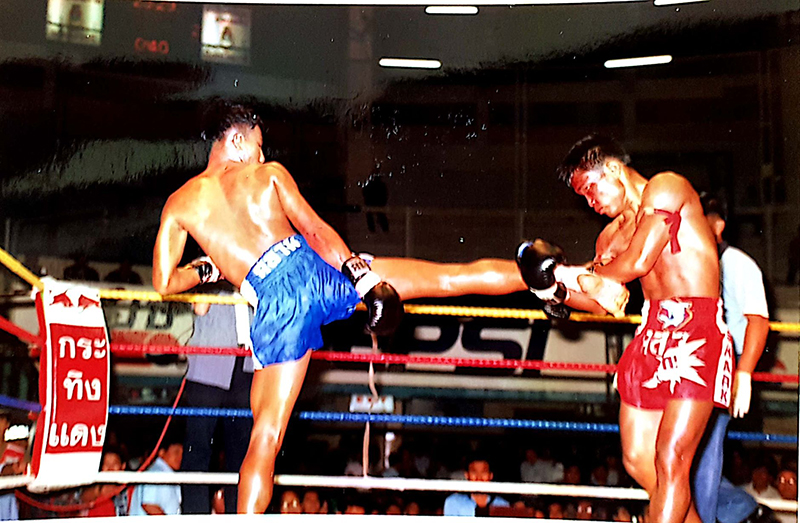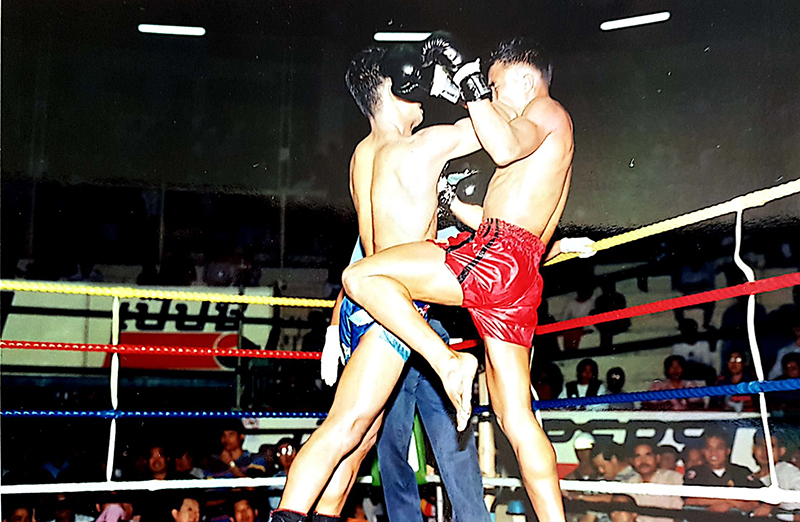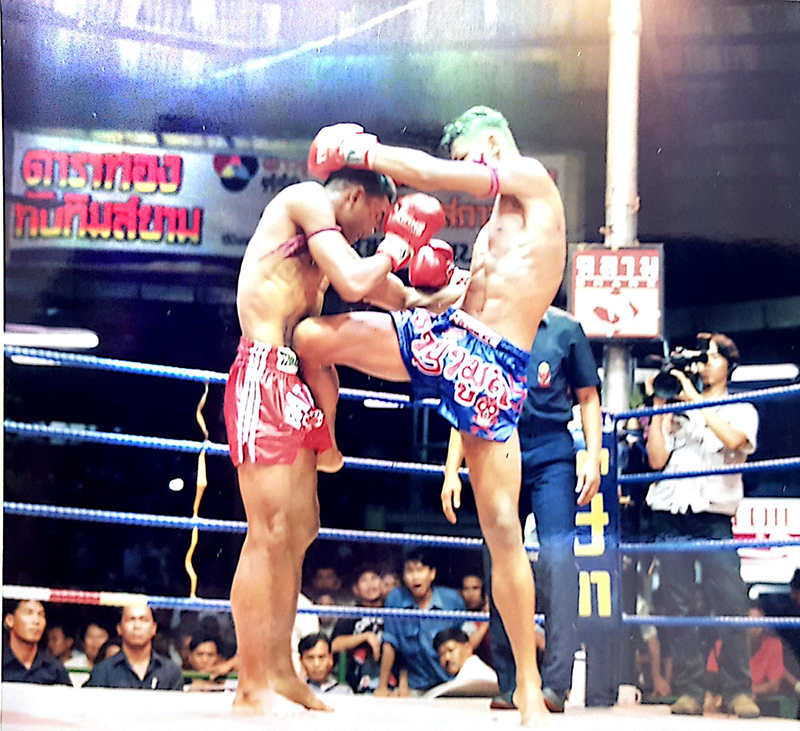
Learning original Muay Thai: the power of team work.
Chapter 1: Pinsinchai boxing camp.
By Marco De Cesaris
From the end of the ’80 to the second half of the ’90 I had the privilege to train in one of the foremost Muay Thai camps in Thailand, the renowned Pinsinchai Gym. Headed by Police General Sawake Pinsinchai, it was one of the most exclusive Kai Muay (training camps) in Bangkok. I attended the camp for several times during those years, mostly for periods of 3 weeks at a time.
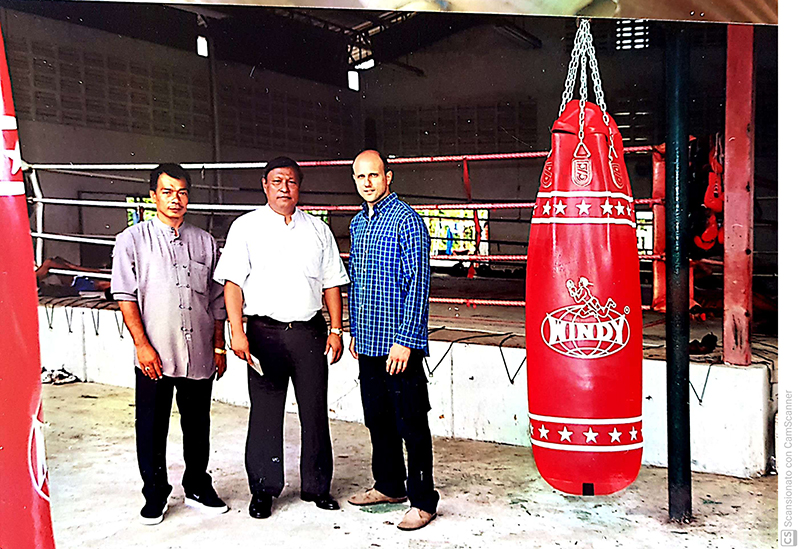
Master Krutsuwan, General Pinsinchai, Marco De Cesaris at Pinsinchai Gym.
Always under the tutelage of my teacher at the time, Master Krutsuwan, I was introduced to a very high level of Muay, something that I never encountered again after then. Apart from the extreme care for physical training (typical of every professional Muay Thai camp), a great part of the daily rigorous routine was devoted to carefully refining all details of a lot of technical maneuvers. Moreover, each fighter was instructed to develop an arsenal of personal fighting strategies aimed at coping with the possible different types of opponents. Looking back now at those days, I can spot the origin of each strategy and technique that I have been taught. I can now recognise those maneuvers as being an adaptation of ancient fighting principles that formed the backbone of what we call today traditional Muay or Muay Boran.
The researchers agree that it was during Rama VI to Rama VIII Eras that all the local styles of Muay went through a systematic transformation that aimed at adapting the old martial techniques and fighting strategies to the new situation imposed by the introduction of new rules, mostly borrowed from Western Boxing. In fact these years are labelled as “development” or “changing” period by the followers of ancient styles: in fact, Muay Thai changed from Traditional (Boran) to Modern. Thai people are very pragmatic: when the needs change, the tools must be changed accordingly. For this reason, all of the main regional styles adapted their skills to the new necessity of competing with rules and regulations they had never used before. Nevertheless, the bedrock upon which the “new” style evolved has to be found in well-established combat traditions.
The most successful teachers were the ones that more efficiently adapted the old style to the new form of ring sport. Along the years, many teachers and training Camps gave their contribution to the development of modern Muay. According to many experts this process reached its apex in the ’80 and ’90: for this reason those decades are often referred to as the Golden Era of Muay Thai. I was extremely lucky to witness and participate in that process, being in the right place at the right time. The skills and knowledge acquired at Pinsinchai Gym helped me (and still help me) to better understand all the nuances of the ancient Siamese styles of hand to hand combat.
Life at the Camp.
The Kai Muay had strict rules and regulations: the first one was a well-defined hierarchy among all the members of that community. The lower rank was formed by new boxers: they had to follow the directions of all other members of the group. Then there were the experienced boxers: some of them (at the time of my stay 5 of them were reigning Rajadamnern Stadium Champions) had special privileges because of their status, but generally they followed the mandates of seniors, coaches and of course the Camp’s owner. The older fighters, just retired or still fighting (yet, not ranked among the top 10 of any of the 3 main Bangkok Stadiums) came next.
I often invited those “old” boxers to compete in Europe and most of the times they easily defeated the best we had to offer at the time. The coaches came next in the Camp’s hierarchy: all of them were former fighters and they were with no exception extremely good pad holders. The core of the daily training of all boxers was the pad work they went through for hours and hours. The pad-men’s ability to feed the fighters with the proper target at the proper time was an outstanding skill that showed an excellent knowledge of the Art and is absolutely not easy to replicate. The head coach, Master Krutsuwan at the time of my stays, didn’t actually hold the pads but mostly supervised the training and occasionally helped fighters to refine specific techniques that needed to be perfected. The top man was the camp’s owner, General Pinsinchai. Generally, he spent some time watching the fighters rehearsing their moves, even if just occasionally: however, while I was at the camp, training with the Seniors or Coaches, under the supervision of my Master, he often took part in the “class” giving special instruction to some of the Top Boxers who then “willingly” spent some time showing me all the intricacies of a given maneuver.
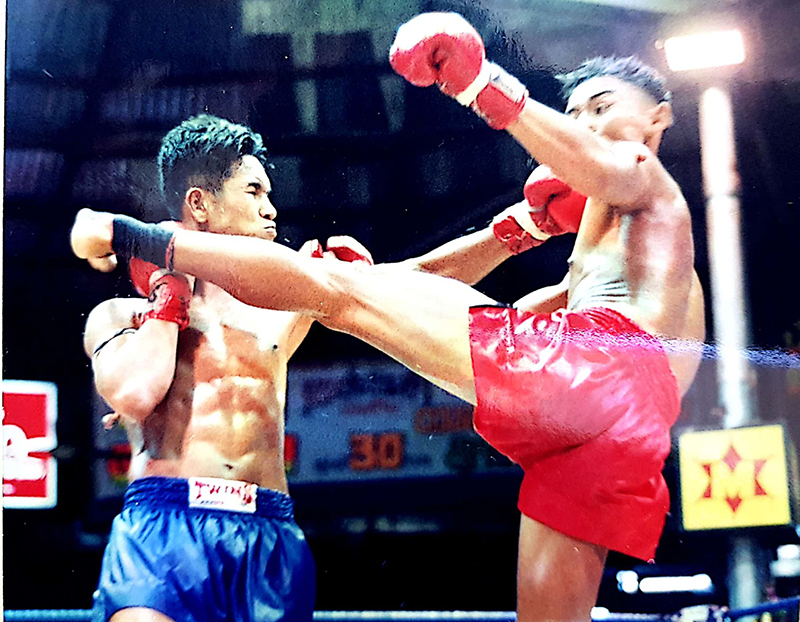
In such a well-regulated community, learning and perfecting fighting techniques and strategies was the main interest of all members. Contrary to a western type of gym, the members of that community lived 24 hours a day in the Camp: they continuously “breathed” Muay Thai and they absorbed as many technical information as possible from their teammates, seniors and coaches all day long. For this reason, we can distinguish two main systems learning systems that are in use in a professional Kai Muay:
1. The first one is learning directly from the teacher (coaches).
2. The second one is learning by yourself looking at others trainees.
Both systems are essential for a fighter’s well-rounded technical, psychological and spiritual development.
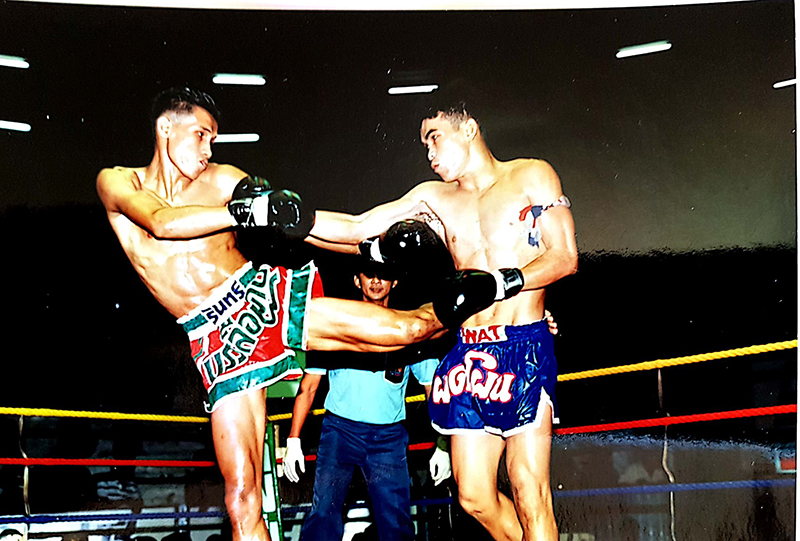
In a Kai Muay the first system cannot be implemented always: most of the times a boxer learns from observing his mates. In fact, while Muay Thai is by definition an individual activity, in a Kai Muay the ‘team’ element plays a fundamental role. Thai Masters express this concept with the saying “Kru Puk Luk Chum” which means learning by watching the others. According to many scholars of boxing techniques this part of learning is just as important as the supervision and advice given directly by the Master. Observing seniors who suffer without showing any signs of fatigue, or absorb body punishment remaining impassive (even if everybody knows this is a mask they wear to hide the opponent their true physical or emotional state) represents an invaluable learning tool for all the members of the team. Continuous contact with expert fighters teaches new students how to totally focus their concentration during the various stages of training. Any negative thought has to be kept away. Since time immemorial Kru Puk Luk Chum learning system has been in use in Siamese Kai Muays and it has proved its high value more and more times. In the years I spent as a professional thai boxers’ coach I constantly tried to replicate that system with my stable of fighters. The resulting relaxed yet energetic training atmosphere has proved very helpful for the members of my team and the results in terms of total wins and title belts very rewarding.
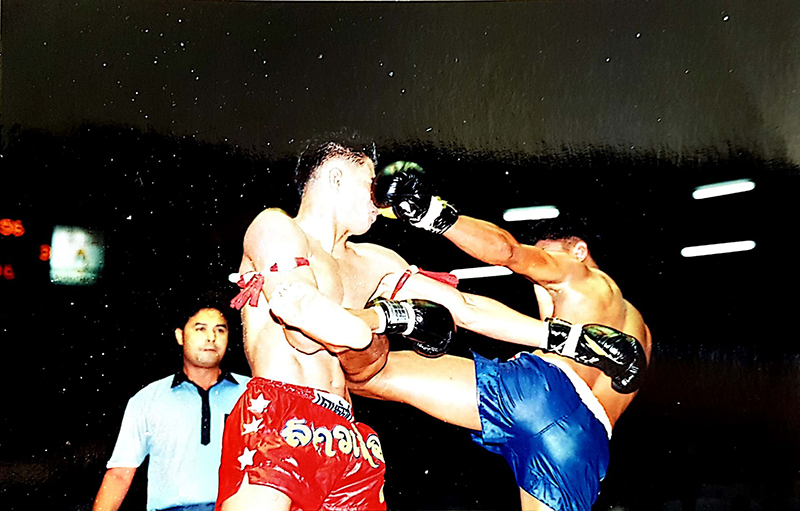
In this series of article I will try to describe the lessons I learned by observing and training together with some of the best fighters of the Golden Era of Muay Thai. Each one of them was a specialist in a specific area of combat: leg kicks, elbow slashes, knee work and so on. From each one of this elite boxers I have learned a lot in terms of pure technique, advanced ring craft and specific training methods to develop top physical prowess in terms of speed, balance, stamina, strenght.
During my stays at Pinsinchai Camp I have trained with the following champions:
Boglek Pinsinchai, Thailand Pinsinchai, Sankaeng Pinsinchai, New Sanchien Pinsinchai, Pumpayak Promachart, Yodkunpon Sittripum. In the upcoming articles of this series I will analyse each one of these great Thai Boxers’ characteristics and strong points: my intent is to share with you the invaluable lessons I have learned from them. Those skills have always been my strong roots along the path of discovering the deepest meaning of the ancestral Art of Siamese Combat.
Next chapter.
Case study: champion Boglek Pinsinchai.
112 lbs (51 kgs)
• 162 wins
• 8 losses
• 0 draws
(95.29% wins)
Champion of Thailand 1984
Lumpini Stadium Champion 1986-1987



